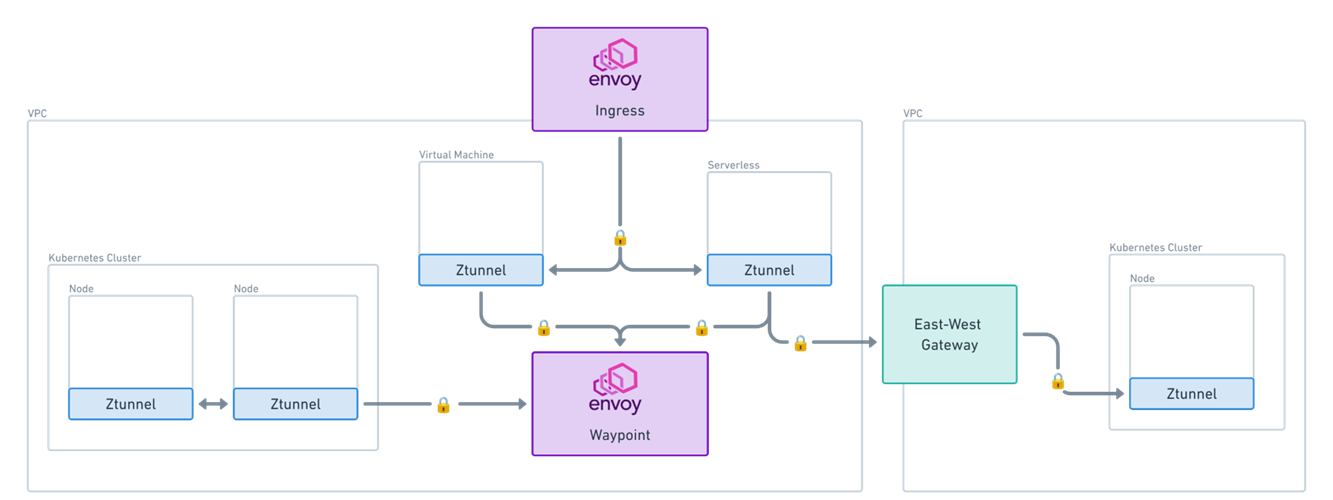How Istio Ambient is Revolutionizing Cloud Connectivity
Network topology complexity is increasing in response to the growing adoption of multi-cloud and hybrid infrastructure. Organizations struggle to connect, secure and observe traffic across these environments as they are forced to use many discrete and poorly integrated networking technologies to achieve their connectivity goals. Kubernetes has done much to normalize the placement and orchestration of workloads but proprietary VM, bare-metal and serverless platforms still abound.
Service mesh solutions exist to abstract away these networking concerns in a platform-agnostic manner. The operational and infrastructure costs of their sidecar-based architectures can however be prohibitive for many use cases. Istio’s new ambient mode was created to address these issues head-on. With its recent promotion to Stable the promise of fast, secure, uniform connectivity across your diverse fleet is now available.
A Paradigm-Shifting Architecture
Ambient mode — the next-generation architecture for Istio — is more than just an incremental improvement to the sidecar-based architecture with reduced costs. While reducing infrastructure costs by up to 90% is nothing to scoff at, ambient mode brings much more to the table.
Ztunnel, a new micro-proxy deployed as part of the ambient mode, is purpose-built to run anywhere, with extremely low overhead. This enables organizations to deploy Ztunnel uniformly across their infrastructure, and substantially enhance their network.
Ztunnel helps:
- Secure — All traffic is automatically encrypted with Mutual TLS and workload identity-based policies can be applied for a zero-trust security posture without relying on IP-based legacy firewall setups.
- Connect — Ztunnel is dynamically programmed by a sophisticated control plane that understands the complex network topologies and facilitates communication across them. This includes several platforms (Kubernetes, VMs, Serverless, etc.) and even across networks (VPCs and data centers).
- Observe — With all traffic flowing through Ztunnel, a single pane of glass into traffic is accessible to gain a complete view of the network.
While Istio sidecars have provided these benefits for thousands of production users over the years, many of these benefits are only fully realized as more and more workloads are enrolled in the mesh. Ztunnel is a game-changer, as not only can it run on virtually any platform, but is also orders of magnitude faster, cheaper, more scalable and easier to operate. This lifts the barriers to widespread adoption.
Taking Control of Traffic
The enhanced network offered by Ztunnel opens the door for rich extensibility possibilities. Utilizing Istio’s advanced routing capabilities, proxies can be transparently injected into the data plane path. Istio calls these proxies ‘waypoints’ and offers an advanced Envoy proxy implementation. As always, traffic to and from the waypoint is fully secured with Mutual TLS.
With these waypoint proxies, users can implement advanced traffic management controls. For instance, users can configure all traffic to a given service to traverse a waypoint proxy, where they can configure controls, such as retries, timeouts, weighted traffic splits (for canary rollouts, A/B testing, etc.), circuit breakers, rich HTTP authorization rules and more. Another powerful use case is applying the same logic, but for egress traffic leaving the environment — here we can apply policies restricting which workloads can communicate to which external websites, or even implement advanced policies such as data loss prevention filters.
Putting it all Together
With these components in place, users can build a modern cloud networking setup with little effort. Istio ambient mode provides powerful functionality while eliminating the need to manage legacy infrastructure components.
Here we can see a glimpse of some of the possibilities that Istio ambient mode opens up. Ztunnel builds a uniform secure network across a variety of platforms — Kubernetes, virtual machines and serverless. This spans across VPCs by utilizing an east-west gateway, all while maintaining mutual TLS encryption end to end. All these destinations can have rich HTTP policies uniformly enforced, powered by ingress gateways and waypoint proxies.
Architecture diagram of a complete Istio mesh environment, utilizing Ztunnel, waypoints and ingress for uniform security and policy enforcement in a heterogeneous platform.



